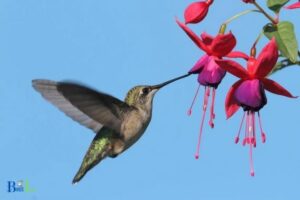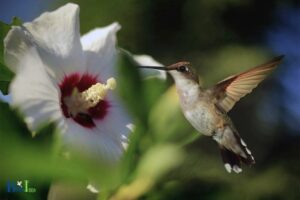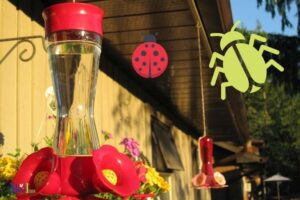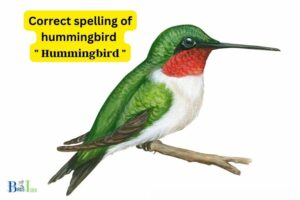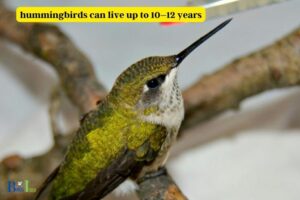What Do Hummingbirds Eat? To Power Their Flight!
Hummingbirds eat nectar from flowers, tree sap, and insects. They rely on flower nectar as their main source of energy, as it is a rich source of essential nutrients.
In addition to flower nectar, they also consume small insects, spiders, and tree sap. Insects provide proteins, while sap and nectar provide the birds with carbohydrates they need to power their flight.
Hummingbirds are capable of hovering and rapidly flapping their wings, and so require significantly more energy for sustenance than other bird species.
As a result, they feed frequently on their diets of nectar, insects, and tree sap, allowing them to fly for long distances and maintain a high level of activity.
DID YOU KNOW
Hummingbird species have been recorded to flap their wings up to 80 times a second and can flap their wings over 52 times a second for long periods of time.

What Hummingbirds Eat In Nature?
Hummingbirds feed primarily on nectar from flowers, but they also get protein from eating insects and spiders, as well as sap from trees and cacti.
Other high-energy foods they eat on occasion include tree sap and juice, fruit such as bananas and apples, processed sugary foods such as jams, and even discarded soda.

Five sources of food that hummingbirds eat in nature are:
“The hummingbird symbolizes hope and light, endurance and the power of life.”
birdsidea.com
What Hummingbirds Eat In Captivity?
Hummingbirds in captivity should be given a diet consisting of sugar water, fresh fruits, and commercial hummingbird feed. Sugar water should be a mix of one part sugar to four parts water and it should be changed daily.

Fresh fruit that can be offered includes banana, watermelon, apple, orange, and peach. Commercial hummingbird feed should be stored in the refrigerator and changed frequently.
Five types of food that should be offered to hummingbirds in captivity are:
- Sugar Water: Sugar water should be a mix of one part sugar to four parts water and it should be changed daily.
- Fresh Fruits: Fruits such as banana, watermelon, apple, orange, and peach can be offered.
- Commercial Hummingbird Feed: Hummingbird feed should be stored in the refrigerator and changed frequently.
- Insects: Insects such as small spiders, flies and aphids are an important part of a hummingbird’s diet.
- Nectar: Nectar from flowers provides a sweet and nutritious treat for hummingbirds.
What Kinds of Food Do Hummingbirds Prefer?
Hummingbirds prefer sweet foods, such as nectar from flowers, sap, and sugary liquid solutions. They also consume small insects, such as spiders and aphids, for protein. To support a healthy diet, hummingbirds should be provided with the following foods:

Nectar from flowers: Nectar from flowers provides hummingbirds with both nectar and pollen. It is an essential part of a hummingbird’s diet.
Fruit: Fruits such as bananas, apples, and oranges offer hummingbirds a sweet treat, as well as additional vitamins and minerals.
Insects: Hummingbirds also enjoy small insects such as spiders and aphids. Protein-rich insects are essential to their diet.
Hummingbird feeder: A hummingbird feeder filled with homemade nectar solution is an easy way to provide hummingbirds with a nutritious and delicious food source.
Tree sap: Hummingbirds also drink tree sap from small shallow pools.
Suet and peanut butter: Suet and peanut butter provide hummingbirds with fat and energy.
Flies and gnats: These insects offer a good source of protein for hummingbirds.
Water: Domestic water or rainwater should be provided in the form of a shallow birdbath or mister.
Hummingbirds require an adequately balanced and nutritious diet in order to maintain good health.
What Nutrients Do Hummingbirds Need?
Hummingbirds need a variety of nutrients to stay healthy and function properly. These include protein, fats, carbohydrates, vitamins, minerals, and water.

Protein is essential for muscle and feather growth, while fats provide additional energy. Carbohydrates help hummingbirds maintain their body temperature and provide energy.
Vitamins and minerals are important for a variety of bodily processes, such as good vision, strong bones, and a healthy metabolism. Water helps hummingbirds regulate their body temperature and flush out toxins.
How Much Food Do Hummingbirds Need?
Hummingbirds require a great deal of food to maintain their high metabolism and energy levels. They feed mainly on nectar from flowers and feeders, small insects, and sap from trees.
Hummingbirds require around 6-8 meals per day and each feeding should be around 3-5 millilitres of nectar.
birdsidea

Here are some other factors to consider when feeding your hummingbirds:
In summary, hummingbirds require a large amount of food, such as nectar from flowers and feeders
What Are The Benefits of Feeding Hummingbirds?
Feeding hummingbirds provides many benefits to the hummers and to backyard enthusiasts. There are several things to consider when selecting a hummingbird feeder, what nectar to offer, and how to properly maintain your feeder. Below are five benefits of feeding hummingbirds:
Provide an alternative food source: Hummingbirds have to eat constantly to survive. By offering nectar, birders can help sustain the hummingbird population.
Stimulate natural habits: By offering nectar, birders can help hummingbirds establish territories, attract mates, and defend their territories from other birds.
Increase viewing opportunities: By offering hummingbird feeders in the garden, birders can bring hummingbirds up close to their yards, providing unique viewing and photography opportunities.
Provide a safe environment: By offering food in a safe and secure environment, hummingbirds will have a better chance of survival against predators.
Attract hummingbirds from long distances: By offering nectar, birders can attract hummingbirds from much longer distances than if they had to find food sources on their own. This helps to ensure that the hummingbirds will visit and stay in the area.
How Can You Attract Hummingbirds To Your Garden?
Attracting hummingbirds to your garden can be done in a few ways. Providing a source of food, either in the form of dedicated feeders with the right type of nectar, or even by planting flowers that hummingbirds like, is one way to attract them.
Additionally, providing nesting materials, especially natural materials such as feathers, dried grasses and moss, can bring them close.
Hummingbirds also like agreeable weather and a diversity of plants and foliage, so creating an environment with plenty of shelter, a water source, and a wide array of plants, can help draw in the birds.
- Provide feeders with the right type of nectar
- Plant flowers that hummingbirds like
- Provide nesting materials such as feathers, dried grasses and moss
- Create agreeable weather conditions
- Provide plenty of shelter
- Include a water source
- Offer a diversity of plants and foliage
- Create cover in the form of trees and shrubs
- Include water features for drinking and bathing
- Incorporate nesting and resting places
FAQ
What do hummingbirds eat?
Do hummingbirds drink nectar?
How long do hummingbirds live?
Do hummingbirds migrate?
Are hummingbirds endangered?
Conclusion
Conclusion: Hummingbirds rely heavily on flower nectar, insects, and tree sap for their sustenance. Nectar is an important source of essential nutrients, while insects and sap provide the proteins and carbohydrates they need to power their rapid flight. As a result, they feed often to maintain their energy levels and keep active.


